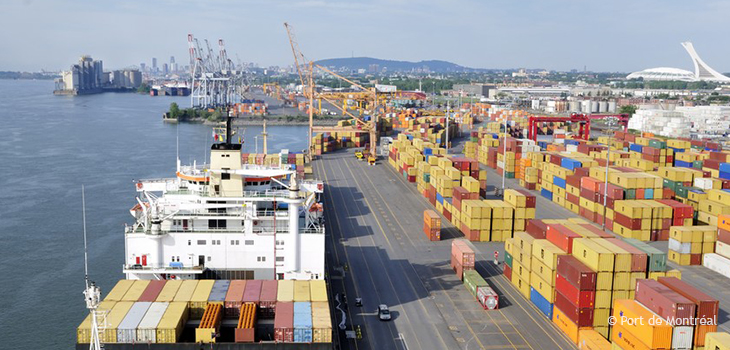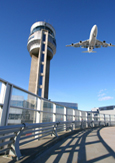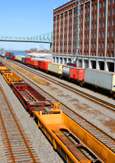
Why Québec?
Transportation Infrastructure
Québec is a gateway to the Americas and provides privileged access to nearly 1.5 billion consumers. Its transportation infrastructure is modern and efficient, allowing goods to be shipped by road, rail, sea or air, or by a combination of these means.
Québec: A champion of intermodal transport

There’s a long history of ingenuity and resourcefulness behind Québec’s intermodal transport system!
Exploring the province’s enormous, 1.7-million-km2 landmass demanded considerable versatility and flexibility as the pioneers learned to adapt to the different seasons and varied terrain. Armed with that experience, Québec has developed a fast and efficient transportation system.
Today, businesses have no trouble moving their goods through a combination of air, rail, road and maritime transportation.
Air transportationExpand/Collapse
 With three international airports, over 130 regional airports and 45 carriers serving more than 150 domestic and international destinations every week, Québec compares admirably to other jurisdictions!
With three international airports, over 130 regional airports and 45 carriers serving more than 150 domestic and international destinations every week, Québec compares admirably to other jurisdictions!
Montréal–Pierre Elliott Trudeau International Airport
Located just 20 kilometres from downtown Montréal, Montréal–PET Airport was used by 19,4 million passengers in 2018.
Since 2000, $2 billion has been invested to modernize or replace the airport’s facilities and bring them up to the highest international standards.
Montréal-Mirabel International Airport
Mirabel specializes in cargo flights. Operating 24 hours a day, the airport provides carriers with very flexible schedules and efficient and modern facilities at competitive prices.
Maritime transportationExpand/Collapse
 The Port of Montréal
The Port of Montréal ![]() is one of the world’s busiest inland ports! It’s also the biggest container port in all of eastern Canada. Located on the St.Lawrence River, one of the world’s major navigable waterways, it provides the most direct intermodal link between North America’s industrial heartland and markets in Northern Europe and around the Mediterranean.
is one of the world’s busiest inland ports! It’s also the biggest container port in all of eastern Canada. Located on the St.Lawrence River, one of the world’s major navigable waterways, it provides the most direct intermodal link between North America’s industrial heartland and markets in Northern Europe and around the Mediterranean.
- Commanding state-of-the-art facilities, Montréal’s port operates non-stop all year long. The road and rail system provides quick access to top markets across central and eastern North America, including states in the Midwestern U.S..
- The Port of Montréal is one of the safest ports in the world.
- The Montréal Port Authority
 is investing in infrastructure so that it can provide optimal service and increase its capacity to handle containerized cargo.
is investing in infrastructure so that it can provide optimal service and increase its capacity to handle containerized cargo.
Rail transportationExpand/Collapse
Québec’s rail system is well integrated into the greater North American rail network, making the train an ideal option for moving goods.

- Every day, container trains head to Toronto, Vancouver, Detroit, Chicago, New York and Philadelphia thanks to a network of over 30 specialized intermodal terminals.
- Canadian National
 (CN) is Canada’s largest rail carrier, with a network extending over 32,000 kilometres (20,000 miles) from sea to sea. CN’s head office is in Montréal.
(CN) is Canada’s largest rail carrier, with a network extending over 32,000 kilometres (20,000 miles) from sea to sea. CN’s head office is in Montréal.
- Canadian Pacific
 (CP) operates a 23,000 kilometres (13,800-miles) network that serves every urban centre in Canada, as well as the U.S. Northeast and Midwest. It provides access to markets in every corner of North America via the Port of Montreal.
(CP) operates a 23,000 kilometres (13,800-miles) network that serves every urban centre in Canada, as well as the U.S. Northeast and Midwest. It provides access to markets in every corner of North America via the Port of Montreal. - The Port of Montréal railway system
 extends over 12 kilometres (7.5 miles) and includes nearly 100 kilometres (62 miles) of tracks along the city’s docks and terminals.
extends over 12 kilometres (7.5 miles) and includes nearly 100 kilometres (62 miles) of tracks along the city’s docks and terminals. - CSX
 : CSX Intermodal, affiliated with CSX Transportation, one of the largest rail companies in the United States, has just built a new terminal in Salaberry-de-Valleyfield, just west of Montréal. The terminal’s strategic location allows for greater connectivity, capacity and efficiencies for all cross-border intermodal freight movements to destinations across North America including Cincinnati, Nashville, Atlanta, Birmingham, Baltimore, Chicago and Cleveland.
: CSX Intermodal, affiliated with CSX Transportation, one of the largest rail companies in the United States, has just built a new terminal in Salaberry-de-Valleyfield, just west of Montréal. The terminal’s strategic location allows for greater connectivity, capacity and efficiencies for all cross-border intermodal freight movements to destinations across North America including Cincinnati, Nashville, Atlanta, Birmingham, Baltimore, Chicago and Cleveland.
Road transportation Expand/Collapse
- North America’s deregulated system ensures highly competitive trucking rates and efficient cross-border traffic.
- The Canada-U.S. border is just a 45-minute drive from Montréal.
- Toronto and Boston are less than a six-hour drive from Montréal, while New York is only seven hours away.
- Québec-U.S. border crossings provide direct access to New York, Philadelphia and Washington D.C.
Other
sites
Productivité innovation website (in French only)
Compétivert(in French only)









